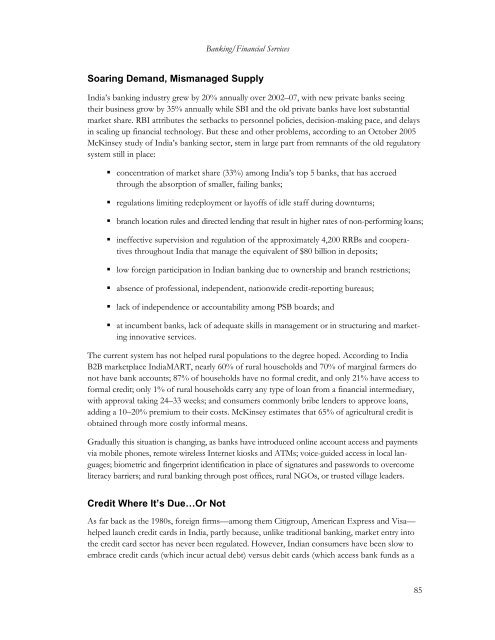PDF: 2962 pages, 5.2 MB - Bay Area Council Economic Institute
PDF: 2962 pages, 5.2 MB - Bay Area Council Economic Institute
PDF: 2962 pages, 5.2 MB - Bay Area Council Economic Institute
Create successful ePaper yourself
Turn your PDF publications into a flip-book with our unique Google optimized e-Paper software.
Banking/Financial Services<br />
Soaring Demand, Mismanaged Supply<br />
India’s banking industry grew by 20% annually over 2002–07, with new private banks seeing<br />
their business grow by 35% annually while SBI and the old private banks have lost substantial<br />
market share. RBI attributes the setbacks to personnel policies, decision-making pace, and delays<br />
in scaling up financial technology. But these and other problems, according to an October 2005<br />
McKinsey study of India’s banking sector, stem in large part from remnants of the old regulatory<br />
system still in place:<br />
• concentration of market share (33%) among India’s top 5 banks, that has accrued<br />
through the absorption of smaller, failing banks;<br />
• regulations limiting redeployment or layoffs of idle staff during downturns;<br />
• branch location rules and directed lending that result in higher rates of non-performing loans;<br />
• ineffective supervision and regulation of the approximately 4,200 RRBs and cooperatives<br />
throughout India that manage the equivalent of $80 billion in deposits;<br />
• low foreign participation in Indian banking due to ownership and branch restrictions;<br />
• absence of professional, independent, nationwide credit-reporting bureaus;<br />
• lack of independence or accountability among PSB boards; and<br />
• at incumbent banks, lack of adequate skills in management or in structuring and marketing<br />
innovative services.<br />
The current system has not helped rural populations to the degree hoped. According to India<br />
B2B marketplace IndiaMART, nearly 60% of rural households and 70% of marginal farmers do<br />
not have bank accounts; 87% of households have no formal credit, and only 21% have access to<br />
formal credit; only 1% of rural households carry any type of loan from a financial intermediary,<br />
with approval taking 24–33 weeks; and consumers commonly bribe lenders to approve loans,<br />
adding a 10–20% premium to their costs. McKinsey estimates that 65% of agricultural credit is<br />
obtained through more costly informal means.<br />
Gradually this situation is changing, as banks have introduced online account access and payments<br />
via mobile phones, remote wireless Internet kiosks and ATMs; voice-guided access in local languages;<br />
biometric and fingerprint identification in place of signatures and passwords to overcome<br />
literacy barriers; and rural banking through post offices, rural NGOs, or trusted village leaders.<br />
Credit Where It’s Due…Or Not<br />
As far back as the 1980s, foreign firms—among them Citigroup, American Express and Visa—<br />
helped launch credit cards in India, partly because, unlike traditional banking, market entry into<br />
the credit card sector has never been regulated. However, Indian consumers have been slow to<br />
embrace credit cards (which incur actual debt) versus debit cards (which access bank funds as a<br />
85








